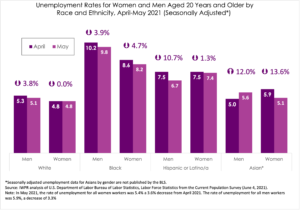FOR IMMEDIATE RELEASE – June 4, 2021
Contact: Erin Weber | weber@iwpr.org | (646) 719-7021
This month’s jobs report from the Bureau of Labor Statistics (BLS) shows that more women returned to the workforce than men, and women gained employment. The Institute for Women’s Policy Research analysis of BLS data shows a return to modest growth, with 314,000 new jobs on payroll for women (56.2% of 559,000 total). Women’s jobs on payroll are still 4.2 million below pre-COVID-19 level, compared with 3.5 million fewer jobs on payroll for men.
“We are all anxious to see employment numbers that will signal we are on a path to full recovery. Unfortunately, we will not see significant shifts until the fall or last quarter of the year,” said C. Nicole Mason, IWPR President and CEO. “Three things need to happen to accelerate a robust recovery: Getting the pandemic under control through increased vaccinations, lifting state and local restrictions safely, and getting schools and daycares fully re-opened. This will make all the difference for women.”
While unemployment improved slightly for Black women and Latinas, it continued to be much higher than White women’s. Black adult women’s unemployment is 1.7 times higher than White women’s, and Latinas’ unemployment is 1.5 times higher. Differences by race and ethnicity narrowed slightly compared to April because White women’s unemployment rate stayed unchanged (at 4.8%).
Looking at the modest gains in Black women and Latinas returning to work, IWPR’s Chandra Childers said, “Many women, particularly women of color, cannot afford to walk away from the labor market.” She noted that there is still a great need for government-subsidized programs that lower the barriers to returning to work, including child care and public transportation.
Women’s job growth was strongest in Leisure and Hospitality, Health and Education, and Government, but these are also the sectors where women still face the largest job deficits compared to pre-COVID times, a deficit of 1.4 million payroll jobs alone in Leisure and Hospitality.
The lack of recovery in the child-care and local education sectors show the continued difficulties for mothers, whether they are working or trying to return to work. IWPR analysis of the new BLS jobs data shows that jobs in the child-care sector improved marginally (by 2.0%) but are still 2.6 times further behind pre-COVID recovery than the overall economy (87% of pre-COVID payroll job levels compared to 95% for all jobs on payroll). Employment in local government schools is still 556,000 jobs behind last February.
“The slow recovery of jobs in child care and education creates double jeopardy for women: the slow recovery of jobs mainly done by women, and the incredible burden on mothers who are working or trying to return to work,” said IWPR’s Ariane Hegewisch. “We desperately need more investment in the care infrastructure to get the economy going again.”
IWPR analysis of the Bureau of Labor Statistics report was provided by C. Nicole Mason, Ariane Hegewisch, Chandra Childers, and Eve Mefferd.






